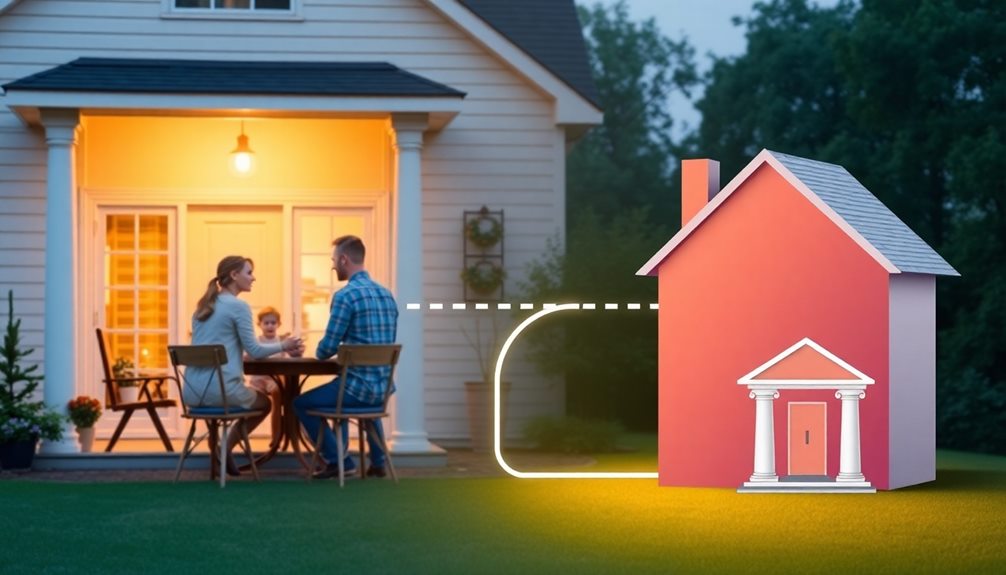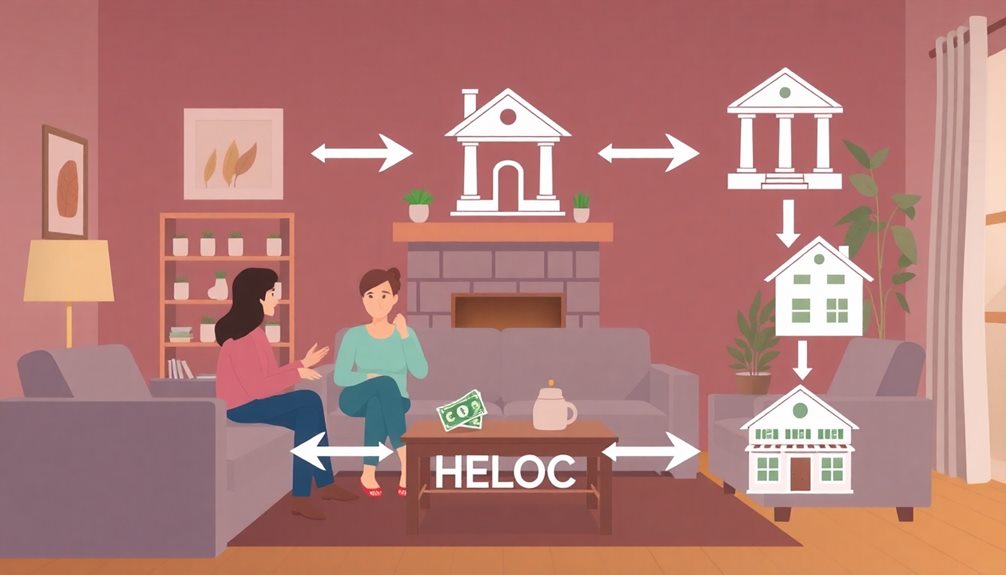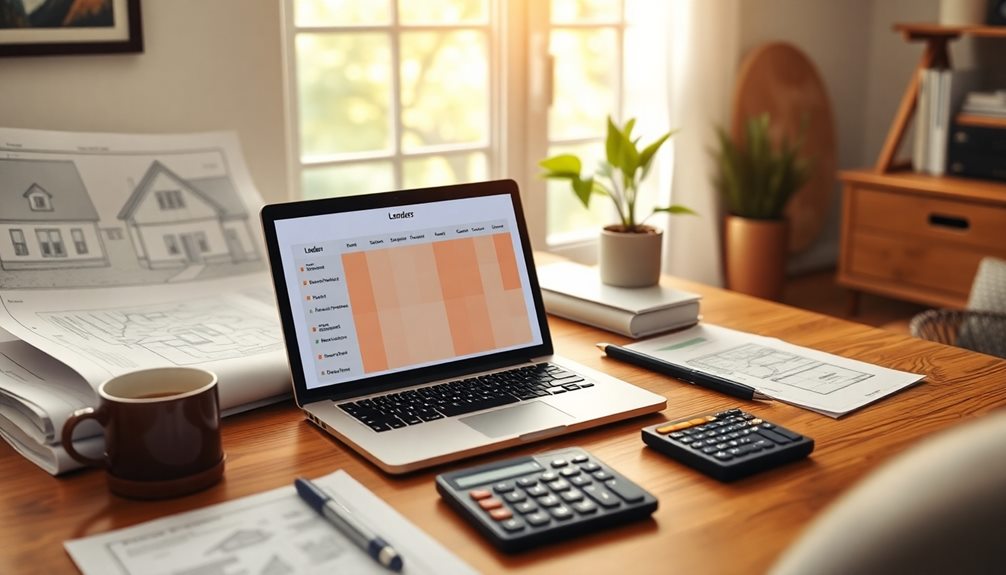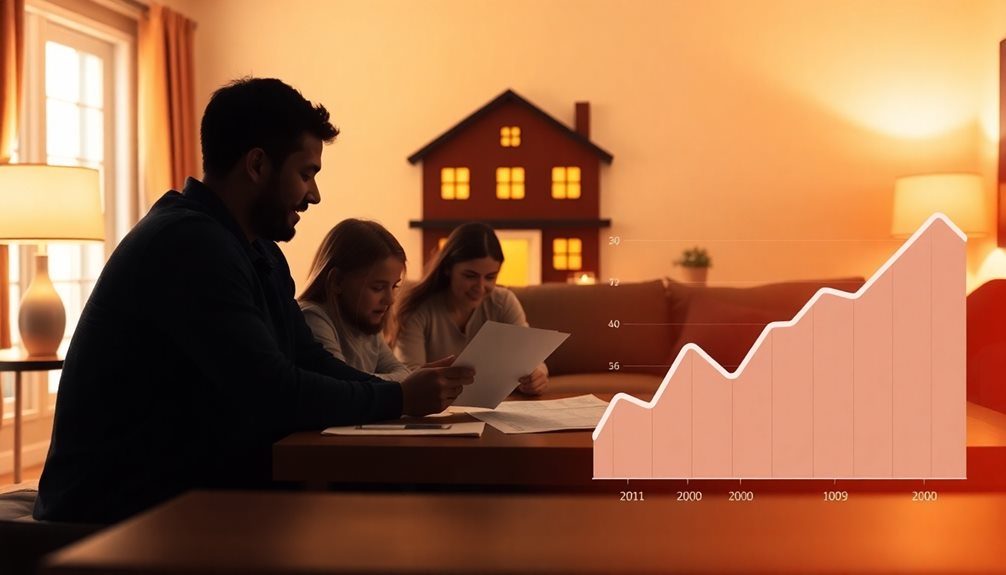A Home Equity Line of Credit (HELOC) allows you to borrow against your home's equity, pretty much like using a credit card. You can access up to 85% of your home's equity during the draw phase, which typically lasts about ten years. Initially, you only pay interest, making it affordable upfront. After that, you'll enter the repayment phase, paying both principal and interest, which can increase your monthly costs. While HELOCs offer flexibility and lower interest rates, it's essential to understand the risks, including potential foreclosure. Stick around to uncover more about the benefits and considerations involved!
Key Takeaways
- A HELOC is a revolving line of credit based on home equity, allowing homeowners to borrow against their property's value.
- It consists of two phases: a 10-year draw phase for interest-only payments and a 20-year repayment phase requiring principal and interest.
- Borrowers can access funds as needed during the draw phase, making it a flexible financial option for various expenses.
- Qualification typically requires a minimum credit score of 620 and a debt-to-income ratio below 43% for better approval chances.
- HELOCs offer lower interest rates compared to unsecured loans, but they carry risks like variable rates leading to fluctuating payments and potential foreclosure.
What Is a HELOC?

If you're considering tapping into your home's value, a Home Equity Line of Credit (HELOC) might be the perfect option for you. A HELOC is a revolving line of credit that's secured by the equity in your home, allowing you to borrow against your property's value.
Typically, you can access up to 85% of your home equity, which is calculated by subtracting your remaining mortgage balance from your home's current market value. To qualify, you usually need at least 15% to 20% equity in your home.
A HELOC has two phases: an initial draw period, often lasting 10 years, during which you can make interest-only payments, followed by a repayment period of about 20 years that requires principal plus interest payments.
Interest rates on HELOCs are generally variable, influenced by market conditions, and are usually lower than those on unsecured loans since they're backed by your home.
One of the biggest advantages is the flexibility it offers; you can access funds as needed for major expenses like home improvements, education costs, or even debt consolidation.
How HELOCs Function

A Home Equity Line of Credit (HELOC) works in two main phases: the draw phase and the repayment phase.
During the draw phase, you can borrow against your home's equity and only pay interest, while the repayment phase requires you to pay both principal and interest.
Understanding how interest rates fluctuate and how much equity you can tap into is essential for effectively managing your HELOC.
Draw and Repayment Phases
Understanding the draw and repayment phases of a Home Equity Line of Credit (HELOC) is important for managing your borrowing effectively.
A HELOC typically includes a draw period lasting around 10 years, during which you can withdraw funds up to a predetermined credit limit. During this time, you only need to make interest payments, giving you flexibility to cover various expenses as needed.
Once the draw period ends, you enter the repayment period, which lasts approximately 20 years. This phase requires you to start repaying both the principal and interest, often leading to considerably higher monthly payments. It's essential to keep track of your remaining balance and repayment schedule during this time.
Interest rates on HELOCs are usually variable, meaning they can fluctuate based on market conditions. This variability can impact your borrowing costs during both the draw and repayment phases, making it important to stay informed about potential changes.
Be mindful that failing to make timely payments during the repayment period can lead to penalties or even foreclosure, as your HELOC is secured by your home.
Interest Rate Structure
When considering a Home Equity Line of Credit (HELOC), it's crucial to grasp how its interest rate structure works. HELOCs typically have variable interest rates tied to the prime rate, which means your interest rates can fluctuate based on market conditions. Initially, during the draw period (up to 10 years), you might only need to make interest-only payments, keeping your monthly payments low. However, once the draw period ends, you'll enter the repayment period, lasting about 20 years, where you'll pay back both principal and interest. This change can lead to considerably higher monthly payments.
Here's a quick overview of how the interest rate structure impacts your payments:
| Phase | Interest Payment Type | Monthly Payments |
|---|---|---|
| Draw Period | Interest-only | Lower initial costs |
| Change Phase | Principal + Interest | Increased monthly costs |
| Repayment Period | Principal + Interest | Higher monthly payments |
Being aware of this structure will help you plan your finances better, ensuring you're prepared for any changes in your monthly payments as interest rates fluctuate.
Borrowing Against Equity
Homeowners can tap into their home's equity through a Home Equity Line of Credit (HELOC), allowing them to access a revolving credit line based on the difference between their home's market value and the remaining mortgage balance. This gives you the ability to borrow against equity without needing to refinance your mortgage.
With a HELOC, you can typically access up to 85% of your home equity. It operates similarly to a credit card, providing flexibility for your borrowing needs.
HELOCs feature two phases: a draw period, usually lasting 10 years, where you can make interest-only payments, followed by a 20-year repayment period that requires you to pay both principal and interest.
Since interest rates on HELOCs are generally variable, you'll want to stay aware of market conditions, as these fluctuations can affect your monthly payments.
Accessing funds is easy too; you can use checks, online transfers, or a linked credit card, giving you various options for tapping into your Home Equity Line when you need it. This makes HELOCs a versatile financial tool for homeowners looking to leverage their assets.
Qualification Criteria

To qualify for a Home Equity Line of Credit (HELOC), you'll need a credit score of at least 620, but aiming higher can get you better terms.
Lenders also look for a debt-to-income ratio below 43%, making sure you can handle your payments.
Understanding these criteria is essential as you prepare to apply for a HELOC.
Credit Score Requirements
Qualifying for a Home Equity Line of Credit (HELOC) hinges greatly on your credit score. Most HELOC lenders look for a minimum score of 620, but some may require a score as high as 700 to offer better terms. A higher credit score not only increases your chances of approval but can also lead to more favorable interest rates and terms, making it essential to know where you stand before applying.
When evaluating your application, lenders will assess your overall financial health, including your debt-to-income ratio. While this isn't the focus here, it's good to remember that a ratio below 40% is often ideal for securing a HELOC.
Additionally, HELOC lenders typically require you to have at least 15% to 20% equity in your home. This means that before you apply, you might need a property appraisal to determine the current market value of your home, which will influence your available credit limit.
Debt-to-Income Ratio
When applying for a Home Equity Line of Credit (HELOC), your debt-to-income (DTI) ratio plays an important role in the approval process. Lenders typically recommend that your DTI ratio stays below 40% for a better chance of approval. To calculate your DTI, divide your total monthly debt payments by your gross monthly income. A lower DTI indicates better financial health, making you more appealing to lenders.
Most lenders prefer borrowers with DTI ratios under 43%, viewing this threshold as a safer level for taking on additional debt, like a HELOC. As a result, maintaining a strong DTI ratio is vital. Along with sufficient home equity and a minimum credit score of 620, a favorable DTI can greatly enhance your eligibility for a HELOC.
Keep in mind that each lender may have different DTI requirements and guidelines, so it's important to shop around and compare terms before submitting your application.
Benefits of Using a HELOC

In today's financial landscape, tapping into a Home Equity Line of Credit (HELOC) can be a smart move for homeowners looking to finance various projects or expenses. One of the biggest benefits is that HELOCs typically offer lower interest rates compared to unsecured loans. This makes them a cost-effective option for borrowing against your home's equity.
Additionally, a HELOC allows for flexible access to funds. You can borrow only what you need during the draw period, usually lasting up to 10 years. This revolving credit structure means you can withdraw, repay, and borrow again without the hassle of reapplying for credit.
Another appealing aspect is the potential tax benefits. The interest on your HELOC may be tax-deductible if you use the funds for home improvements, which can greatly reduce your overall borrowing costs.
Here's a quick overview of the benefits:
| Benefit | Description |
|---|---|
| Lower Interest Rates | More affordable borrowing costs compared to loans |
| Flexible Access | Borrow only what you need during the draw period |
| Tax-Deductible | Interest may be deducted if funds are for home improvements |
Risks and Considerations

While a Home Equity Line of Credit (HELOC) can provide valuable financial flexibility, it's important to understand the associated risks and considerations before diving in.
One major risk is foreclosure since HELOCs are secured by your home. This means that if you miss payments, you could potentially lose your property.
Additionally, most HELOCs have variable interest rates, which can cause your monthly payments to fluctuate and lead to unexpected increases in your overall borrowing costs during the repayment phase.
Another factor to take into account is the closing costs and fees that come with obtaining a HELOC. These can add to the total cost of borrowing, so be sure to factor them into your decision-making process.
Market fluctuations can also impact your home's value, creating situations where you might owe more on your HELOC than your home is worth, leading to negative equity.
Choosing the Right Lender

Finding the right lender for your Home Equity Line of Credit (HELOC) can make a significant difference in your borrowing experience. Start by comparing interest rates, as they can vary widely depending on your credit score and equity position. You'll generally find rates lower than those for unsecured loans, which is a plus.
Additionally, understanding how IRA Inheritance Rules can impact your financial planning may help you make better-informed decisions regarding your borrowing options. Look for lenders that offer favorable terms, such as no or low closing costs, and consider those with promotional rates for new customers or discounts for existing clients.
It's also essential to assess the lender's reputation. Check customer satisfaction ratings and feedback to guarantee a positive borrowing experience; lenders like Fairway Mortgage are often praised for their service.
Don't forget to inquire about the maximum borrowing limits available. For instance, TD Bank offers HELOCs up to $6 million, which could be advantageous if you have substantial home equity.
Frequently Asked Questions
What Is a Disadvantage of a Home Equity Line of Credit?
One major disadvantage of a home equity line of credit is the risk of foreclosure. If you miss payments, your lender can seize your home, leaving you in a vulnerable financial position and facing potential loss.
What Is the Monthly Payment on a ,000 Home Equity Line of Credit?
You might worry about high payments, but for a $50,000 HELOC, expect interest-only payments around $100 to $250 monthly during the draw period. Just remember, rates and terms can vary, impacting your overall costs.
How Do Payments Work on a Home Equity Line of Credit?
Payments on a home equity line of credit typically start with interest-only during the draw period. Once it ends, you'll pay both principal and interest, which increases your monthly payments considerably. Stay mindful of your budget.
What Is the Monthly Payment on a ,000 HELOC?
Picture your dreams within reach; a $100,000 HELOC's monthly payment typically ranges from $250 to $500 during the draw period. But be prepared—repayment can soar to around $660 to $700 later on.
Conclusion
In conclusion, a Home Equity Line of Credit (HELOC) can be a flexible financial tool for homeowners. Did you know that, on average, homeowners can access up to 85% of their home's equity? This means you could access significant funds for home improvements, debt consolidation, or unexpected expenses. Just remember to weigh the benefits against the risks, and choose the right lender to make the most of your HELOC experience.










